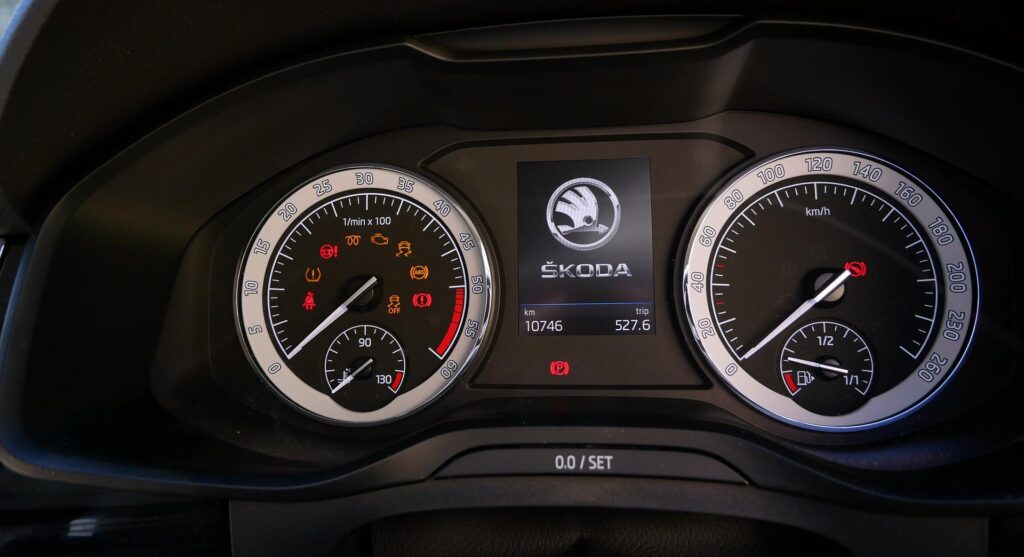There are always reports about Skoda diagnostic equipment in the trade press and in the various media on the Internet. In most cases, however, it is not addressed when a Skoda diagnostic device can be useful or is actually needed. In this article, we would like to discuss this and give practical examples of when a Skoda diagnostic device can be used expediently.
The check engine light and its consequences!
One of the worst surprises when driving a car can be the sudden illumination of the check engine light . This usually happens when there are long trips ahead or the vehicle in question is absolutely needed. The check engine light indicates problems in the vehicle, but offers only limited information that most drivers often cannot interpret correctly. Therefore, we would first like to discuss the various errors that the check engine light can indicate. A little later, in this text, we will inform you about when a Skoda diagnostic device is needed.
GAIN MORE CONTROL OF YOUR CAR WITH THE CARLY FEATURES
Check the exact pricing of Carly for your car brand!

Fast International Shipping with DHL

14 days adaptor return policy

Excellent customer support

Lifetime warranty in the hardware
SEEN IN
The check engine light is standardized and looks the same in every vehicle. It represents a stylized engine that lights up briefly when the ignition is turned on. This is to ensure that the light works and can indicate errors when driving. This is the reason why it lights up for a few seconds as soon as you turn on the vehicle. Only when it no longer goes out or starts flashing can this be a sign of problems in the vehicle. For this reason, we would like to take a closer look at the various display options of the engine control light.
The engine control lamp lights up briefly when the engine is started
In this case, there is no error. The brief flash when the ignition is turned on is a check function so you know the check engine light is working properly.
The engine control lamp lights up continuously and no longer switches off!
The continuous illumination of the engine control light is intended to indicate that a fault has been found. Although this does not currently pose a concrete danger to the engine or the environment, it should be rectified immediately. In this case, a Skoda diagnostic device can be useful to identify the cause of the problem.
The engine control light flashes very fast and does not switch off anymore!
The rapid flashing of the check engine light is intended to indicate that a serious defect has been detected on the vehicle . On some vehicles, an emergency program is initiated in which the vehicle’s performance is reduced. The ride should be stopped as soon as possible because there is a danger to the engine or the environment. In this case, a Skoda diagnostic device is urgently needed to identify and eliminate the source of the error.
The check engine light is active, how can I find the error?
The check engine light is triggered by the electronic control units of a vehicle. Modern vehicles have up to 100 different control units, each of which can be used for a specific function. These include safety-relevant functions such as the engine management system or the anti-lock braking system. However, they can also perform functions that are solely responsible for the occupants’ place of comfort, such as climate control. All of these control units have the ability to read data through various sensors and respond to it with actuators. If data is read in that is outside the defined rings, error messages can be stored in the control unit.
Error messages can basically be triggered by very different components. An error or even a whole series of errors can be displayed, which were triggered by a defective component. For example, it can lead to increased pollutant emissions if the swirl flaps in the intake tract are defective. As a result, error messages are triggered in some control units, which have the task of controlling the amount of pollutants. Even simple problems such as leaks in the intake or exhaust tract can release error messages.
If the check engine light flashes constantly, there is not necessarily a serious fault. Unfortunately, a visual inspection of the engine and the various exhaust components is only possible in very few cases. To find out the cause of the problem, a Skoda diagnostic device is needed. This is only connected to the OBD diagnostic connector and is then immediately ready to read out the error messages. Modern Skoda diagnostic devices not only show users the fault codes, but also provide additional information that can be used to quickly identify the source of the fault.
IMPORTANT!
Even if the constant flashing of the check engine light should indicate a fault that does not represent fatal consequences for the engine and the environment, a diagnosis should be carried out as soon as possible. The error in question can cause consequential damage, which can have serious and expensive consequences. The errors must be read with a Skoda diagnostic device so that they can be eliminated and checked after the repair.

The check engine light flashes constantly, what can I do?
A serious fault is to be indicated by a constant flashing of the engine control light. In this case, the vehicle should be stopped as soon as possible in order to remedy the cause immediately . Diagnosis of the present problem can be performed only with a Skoda diagnostic device. Since a direct danger to the engine and the environment cannot be ruled out, rapid rectification of the faults in question should be carried out immediately.
In this case, a Skoda diagnostic device is the only way to read the relevant error messages and thus quickly and effectively identify the source of the error. In modern vehicles, it is no longer possible to carry out repairs to the various vehicle components in any other way. If the engine light flashes constantly, the error can only be detected with a Skoda diagnostic device, or the visit to a specialist workshop, but this may lead to high repair costs. So just in case the check engine light indicates one or more faults, it is worth investing in a Skoda diagnostic device.
Is the use of a Skoda diagnostic device only worthwhile in case of problems?
We are constantly dependent on our cars these days. Whether they are used to get to work on time, take the kids to school, or do the weekly grocery shopping, we can no longer get by without our motor vehicle. We must therefore not only ensure the safety of our vehicles for financial reasons, but also secure our day-to-day organization with them. A Skoda diagnostic device offers the best conditions for this in both cases.
If the vehicle’s fault memory is read out at regular intervals, the owner will be aware of any problems that may arise. Modern Skoda diagnostic devices, such as the Carly OBD scanner, can read the entire information from the ECUs and thus not only make a diagnosis of the current state of the vehicle. With the help of all the data, predictions can be made as to which parts in the vehicle could fail in the future and thus jeopardize the reliability of the car. This makes it possible to plan repairs in advance,
so that no financial problems arise and the reliability of the car is constantly guaranteed.
A Skoda diagnostic device can be a comprehensive tool if you always want to keep your vehicle in good shape. The investment can therefore pay for itself in a short time.
Why is the Skoda diagnostic device so practical?
Nowadays, a Skoda diagnostic device can be used as a general-purpose tool when diagnosing a vehicle. However, this only applies to vehicles built after 1996. This is related to on-board diagnostics (OBD), which was introduced by the California Air Resources Board in 1988. At that time, the U.S. agency established new emissions regulations to protect California’s major cities from the effects of vehicle exhaust.
However, it was clear to the agency’s staff that it was not enough to develop regulations only for new vehicles, but also to ensure the vehicles’ emissions behavior over their entire lifetime. On this occasion, they developed OBD, the first version of which was mandatory for vehicles in California as early as 1988. Thus, the OBD ensures the function of all components that are important for compliance with emission regulations. The authority is also responsible for the check engine light, which should indicate damage in the important components. The California Air Resources Board also stipulated that vehicles must have a diagnostic connector that not only allows authorized repairers to read the ECU’s fault memory, but also to effectively troubleshoot the exhaust system.
The OBD1 standard quickly became obsolete as more and more electronics were used in vehicles. The OBD2 standard became mandatory in the USA for vehicles built in 1996 and later. This also makes it possible to read out all other ECUs that are not directly connected to the exhaust system. In modern vehicles, the various control units can exchange information and data with each other to perform even very complex tasks. This means that the OBD2 diagnostic connector can be used not only to read out all the current data from the control units, but also to change settings and read and delete error messages.
Therefore, with a modern Skoda diagnostic device, such as the Carly OBD scanner, all the necessary information can be read out, with which a vehicle can be diagnosed and checked.
Error codes and the Skoda diagnostic device
Reading out error messages and clearing them if necessary is one of the most important reasons for using a Skoda diagnostic device. Proper use of this device requires that the user has informed himself about the function of the control units and knows how error messages or error codes are generated. For this reason, we would like to go into a little more detail about the function of the control units and explain how, where and why error codes are stored.
Nowadays, up to 100 different control units are used in a modern vehicle. They are each developed for a specific purpose. The first control units were used for engine control. They enable precise control of the engine to ensure the most efficient consumption possible with the highest possible performance. With the further development of technology, control units are nowadays claimed for many different functions in the vehicle. They can control the anti-lock braking system and even be used in automatic climate control malfunction.
Their common feature is that they can read data through sensors and are capable of triggering operations through actuators when necessary. If data is read in or it is determined that something is outside a defined ranking list, the control units can generate error messages. Normally, the errors are stored in the bounce memory when they occur for the first time. Only when the error is detected again in a later run is an error code generated and stored in the error memory. Depending on how important the error is for the function and safety, can be triggered by an error code in a vehicle operation to protect the user or the engine. In the worst case, the engine power is throttled back to prevent consequential damage.
What do error codes look like?
When the U.S. Air Resources Board introduced the first OBD standard in 1988, officials also considered error messages. So that they could be read not only by the technicians in the contract workshops, it was also determined how the errors were composed. The DTC (Data Trouble Code) was developed, in which more than 11,000 error codes have already been defined. In addition to the error messages defined by the authority, manufacturers can also use their own error codes if required. The DCT consists of five different digits as follows.
The first digit indicates the location where the fault occurred in the vehicle. For example:
– P – Powertrain – Drive train
– C – Chassis – Chassis
– B – Body – Body
– U – User Network – Communication Networks
The second digit in the DTC can be used to indicate a general error (0) or a specific manufacturing error (1). The third digit in the DTC indicates the exact location of the component that issued the error code. You can find an excerpt of the characters used for this here:
– 0, 1, 2 – air or fuel metering control
– 3 – Ignition system
– 4 – additional emission control
– 5 – Motor run control
– 6 – Onboard computer
– 7, 8, 9 – Gearbox control
– A, B, C – Hybrid drive
The last two digits of the DTC are then used to identify the specific error. How the marking is to be done is specified in the SAE J2012 and ISO 15031-6 standards. As previously mentioned, vehicle manufacturers can also define their brand and type-specific error messages. You only have to follow the given standards and the DTC.

The Skoda diagnostic device and the modes of OBD
In order to use a Skoda diagnostic device efficiently, the user has several modes at his disposal. These can be used depending on the type of diagnosis and can also trigger manufacturer-specific test functions. The following modes are offered in OBD for diagnosis with a Skoda diagnostic device:
1. vehicle-specific diagnostic data
In this mode, data values and sensor data can be queried in real time. This function can also be used to query the “Readiness Code”, which displays all components installed in the vehicle in a 12-digit binary code.
2. error environment data or freeze frame data
When the control units detect a fault and the warning light is activated, freeze frame data is acquired and stored for this purpose. At the time of the fault, they are a snapshot of the data from the components and sensors. These can help diagnose the defect, as all data can be displayed from the time the fault occurred.
3. permanent error codes that cause the warning lamp to light up.
In this function it is possible to recall all the defects that led to activation of the warning lamp in the dashboard. Vehicle manufacturers also have the option of defining their own fault codes that can cause the warning light to be triggered and are stored in this memory area.
4. Löclearing of the exhaust gas relevant error codes and error environment data
In this mode, all emission-relevant data can be deleted with the Porsche OBD scanner. This includes the error memory and the freeze frame data. Under certain circumstances, the manufacturer-specific error messages can also be deleted here.
5. monitoring of the lambda sensor
This function can be used to query the continuous monitoring of the lambda sensor and display the test results.
6. systems that are not continuously monitored Error messages
that did not activate the warning lamp are stored in this area. The errors have been detected but have no systemic consequences to activate the warning light.
7. continuously monitored systems, warning light not active
All data that triggered an error message only in one work cycle and were not sufficient to store an error code can be queried in this mode. They can help identify potential sources of error.
8. manufacturer-specific test functions
In this mode, manufacturers can include their own test functions. However, this function is not usually used by European brands.
9. vehicle identification
In this mode, important data can be retrieved from the vehicle, which is stored in various control units. This includes, among other things, the vehicle identification number (VIN) and brand- and type-specific information.
10. mode 0A
In this mode, the diagnostic device can read all error codes with the status “permanent DTC” and they will not be cleared in the ECU until the error can no longer be detected.
Can a Skoda diagnostic device also be used on other vehicles?
OBD was developed so that the components in a vehicle that play a crucial role in emission control can be checked. The fault codes defined in the DTC can therefore be read out by all vehicles, regardless of manufacturer. However, since vehicle manufacturers also have the ability to develop their own fault codes, these can only be read by OBD scanners that can also interpret these codes.
In addition, on modern vehicles, settings can be changed through the OBD diagnostic connector, thus personalizing a vehicle. This can only be done with OBD scanners that support these types of vehicles. So you can read out all standardized error messages with a Skoda diagnostic device, but you may not be able to use manufacturer-specific options.
However, with Carly’s OBD scanner, you have the option to upgrade the software as needed. If it is necessary to diagnose a vehicle from another manufacturer, you can simply use another or additional subscription model and use the scanner to read out other vehicles as well.
The Carly OBD Scanner uses an adapter that plugs into the OBD diagnostic connector and connects to the smartphone or tablet. The data is then transferred to the smartphone and analyzed using the Carly app. The memory capacity and computing speed of modern cell phones are used to implement analyses and diagnostic techniques that are not possible with normal OBD scanners. In addition, the software on the smartphone can ensure that the OBD scanner does not become obsolete. In a few minutes, the software can be updated and also customized to the user’s requirements. Carly OBD Scanner is a flexible and practical solution to diagnose a modern vehicle and exploit all the possibilities offered by modern ECUs in a vehicle. The software is designed so that it can be used by beginners and specialists without the need for special expertise or training. A simple way to ensure the safety of a vehicle and to be able to intervene quickly in case of problems.

